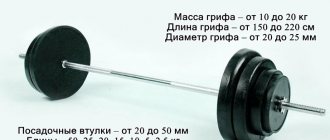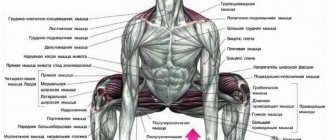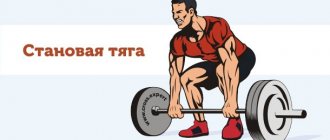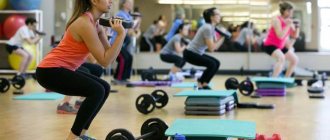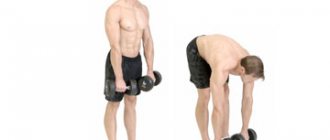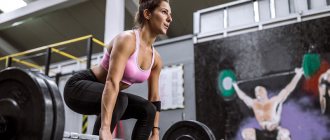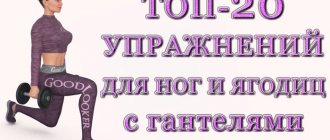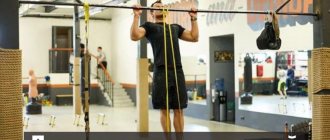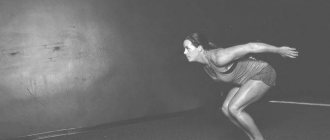There are a lot of back exercises. Lever traction is an option for those who need to work the muscles in independent planes, that is, perform movements on both the right and left half of the back separately. The linkage can be vertical or horizontal. The first option is more aimed at the width of the back, the second - at “depth”. The most popular exercise is the seated Hummer row. It is performed with your stomach resting on the machine’s cushion, and allows you to work your back through a deeper amplitude than the usual block row while seated to the waist. The exercise complements the basic back movements and is used in both bodybuilding and health fitness. Lever trainers are also good for correcting posture and rehabilitation after injuries.
Execution technique
Initial position
- The weight is hung on a lever structure. Beginners should start with light weights, as the Hummer's arms themselves also have a certain weight;
- The support of the exercise machine is adjusted so that the athlete comfortably reaches the handles with his hands;
- A straight grip is performed so that the middles of the handles lie in the middle of the palm;
- If your hands slip, you can use straps
Movement
- The work begins not with bending the elbows, but with bringing the shoulder blades towards the spine;
- It is necessary to bring the shoulder blades towards the spine, as if turning both halves of the back back;
- At the same time, flexion occurs at the elbow joint, the lever structure is attracted to the body;
- As you inhale, return the arms of the simulator to their original position.
Attention
- Work in the Hummer is isolated, you don’t need to try to strain your biceps as hard as you can to pull the weight deeper into your stomach;
- You should exclude “rowing” in the simulator, that is, movement in the lumbar spine, which helps bring weight to the stomach;
- You need to activate your lats, learn to tense them, and not pull the weight towards you with your biceps;
- There is no consensus regarding kyphosis - some sources recommend not rounding the back in the starting position, others believe that such a start will only improve the traction itself and allow the athlete to stretch and contract the back muscles more. In reality, everything depends on the condition of the thoracic spine and the readiness of the back muscles. If the thoracic region is injured, then you should choose an exercise with a more stable back position.
Horizontal LEVER ROD!!! Kock technique!) VOD
Recommendations
- The “jerky” style is not acceptable. It is better to gently pull a less significant weight than to sharply push a more significant one;
- If the exercise is performed with both hands at the same time, you need to synchronize their work and avoid “getting ahead” with one hand. This will allow you to avoid problems with muscle imbalances and poor posture;
- It is necessary to master the skill of starting “from squeezing the shoulder blades”, and not from bending the elbows, so that the back muscles are involved in the work, and not the biceps;
- If an athlete has problems with the start, it is worth switching to the “one-armed” deadlift and practicing the skill in turn for each half of the back.
Effective lat training on a vertical block
There is no point in performing a large number of exercises on a vertical block, since approximately the same muscles work.
You need to choose two types of traction from those we talked about. For example, wide-grip and narrow-grip rows, or overhead rows and one-arm rows. The main thing is that the exercises affect different areas of the back!
An example complex might look like this:
- Wide grip rows – 3-4 sets of 8-12 reps.
- Close grip rows – 2-3 sets of 8-12 reps.
After completing the complex, you can perform stretching exercises.
Execution options
One-arm lever row
To perform rows with one hand, it is necessary to fix the body so that the other hand can grab the handle of the machine. The “non-working” half of the back is stable, the scapula is brought to the spine and lowered to the pelvis. The working half of the back begins by bringing the scapula toward the spine and synchronously flexing the elbow joint. The technique is similar to a conventional lever pull. This exercise allows you to balance muscle development and achieve an even gain of muscle mass. For those who have spinal curvature and poor posture, this is a priority movement.
Upper hummer thrust
The row in a vertical machine is very similar to the row of the upper block. This version of the exercise is considered more “advanced”, since in a lever simulator the exercise can be performed with one hand. If you compare the work of the muscles, there is no difference in the exercises, and the pull-down of the upper block can also be done with one hand. This traction option is suitable for those athletes who cannot perform pull-ups. The technique of execution is absolutely the same as when performing lat pull-downs.
- While performing the movement, your back should be kept straight and your lower back should be arched.
- Exhale while pulling the weight down.
- And inhale while returning the load upward.
To further engage the latissimus dorsi, you can lean your torso slightly forward.
Analysis of the exercise
What muscles work
- The main muscles are the latissimus and posterior deltoids, plus the rhomboid muscles of the back due to the adduction of the scapula to the spine.
- Auxiliary muscles are the abs and longus dorsi as stabilizers, biceps, forearm muscles, teres major and minor, and trapezius muscles.
Benefits of Exercise
- The work of the lats is quite difficult to isolate. In classic rows with a barbell and dumbbells, the stabilizers, legs, muscles, and core are significantly involved. This movement allows you to completely transfer the load to the widest;
- The design of the simulator is such that a powerful athlete can receive the required amount of load in it and will be able to perform the exercise with significant weight, and a beginner will be able to work on technique, posture and use the weight that will be suitable for him;
- The exercise allows you to work both “halves” of your back separately and avoid muscle imbalances;
- The amplitude of the work in the Hummer is slightly greater than when performing a conventional block pull. The exercise is performed with maximum stretching of the muscle, this helps to get excellent quality muscle development;
- Using the machine allows you to exercise safely and will help beginners develop the necessary neuromuscular connections and learn to feel their muscles before moving on to free weights.
Flaws
- The movement is not accessible to all athletes due to the fact that the exercise machine is quite rare in minimalist gyms. Large fitness centers are already buying a car, while smaller ones are forced to make do with only a crossover;
- The exercise is not suitable for athletes with very short arms and short stature. They simply do not have enough arm length to effectively work in the machine;
- Beginners can pull the levers toward themselves using their biceps rather than their back; this does not allow them to achieve the goal of the exercise;
- There is a risk of injury if the weight is selected incorrectly. Many people like to “hang” a large amount in the block simulator and then pull it due to inertia, but this is not the right strategy. For an isolation exercise, even for a strong muscle group, medium weights are required.
Lever rod: technique and nuances
Advantages and disadvantages of linkage
Advantages
- Due to the fact that each lever of the simulator is independent of each other. We can perform rows on each side separately. This will eliminate the imbalance in their development.
- This row allows you to work your back muscles in isolation. This is achieved by resting the chest on a soft pillow with horizontal traction. Thanks to this we get an additional point of support. And in an extended position, the weight of the simulator will not be able to pull us along with it. With vertical traction, we fix our legs by putting them under the bolsters.
- Working in a lever machine, we can achieve a much greater range of motion than in the same block. This will allow more muscle fibers to be involved in the movement. Making our training as effective as possible.
- When performing deadlifts on a lever machine, we have a more stable body position. So we don't have to focus on our sustainability. This will allow you to concentrate entirely on the work of the latissimus muscles. And strengthens the neuromuscular connection.
- The motion vector is set by the simulator itself. Therefore, the exercise takes place in one plane. Consequently, the stabilizer muscles are activated much less than in block and conventional deadlifts. Which gives us the opportunity to perform the exercise only by contracting the lats.
- The lever trainer allows you to deadlift heavy weights.
- Ease of mastering the technique. Which makes lever traction accessible not only to professionals. But also for less experienced athletes.
As you can see, the list of advantages is very impressive. And remembering the previous question about whether a lever trainer is needed or not. I think the answer is obvious. But in order for our understanding of the exercise to be more complete, we need to note its disadvantages.
Preparing for the exercise
The trajectory should be selected so that it is close to horizontal. This is the optimal type of motion trajectory. The horizontal position is achieved by correctly setting the seat height. The athlete must touch the pad of the exercise machine with the solar plexus; if this is not the case, the exercise is performed incorrectly, due to “breaking with the biceps.”
The height of the seat should be such that your feet touch the ground completely and are stable. The grip is selected so that the work trajectory is close to horizontal. There should be no discomfort in the shoulder joints.
Correct execution of the exercise
- If you look at the athlete from the side, his forearms move parallel to the floor, in a straight or slightly elliptical path; in the second version, the emphasis is on tightening the elbows to the body, and this version of the movement involves the rhomboid muscles more;
- When performing a deadlift, the arms move at the same speed and do not allow one to get ahead of the other;
- The amplitude of movement should be kept as close to natural as possible. Throwing your elbows over your waist should be avoided so that the work is in the optimal trajectory;
- The support pillow is located at the solar plexus throughout the entire movement; displacement along the axis perpendicular to the spine is not allowed during operation;
- The choice of grip is relevant if the simulator has a flexible handle design. That is, they rotate around their axis, and you can turn your palms inward or parallel to the plane of the floor;
- The main load falls on the latissimus muscles; you should not pull with the biceps;
- Movements with one hand are allowed, but in all technical versions of the exercise it is necessary to pull the shoulder blades towards the spine.
Technical characteristics of the Hammer simulator:
- The frame of the Hummer simulator is made of thick-walled profile pipe 40 x 80 mm.
- The rotation units are closed ball bearings.
- The load on the simulator is provided using Olympic or training discs with a mounting hole diameter of 51 mm.
- The upholstery is made of vinyl artificial leather with a high-strength nylon base.
- The soft elements of the strength training device are filled with foamed polyurethane foam.
- The base for the pillows is multi-layer plywood on a steel base.
- The coating of rubbing and guiding parts is complex galvanic (chrome + nickel).
- The supporting parts of the machine are steel legs with holes for fastening to the floor.
- Permissible load on the moving part of the overhead pull simulator: 350 kg.
- Dimensions: 1700x1385x2000 mm.
- Weight of the strength trainer: 115 kg.
- The Hammer exercise machine lever pull from above on free weights has no limit for athletes in terms of height and weight.
Errors
- “Rowing” with the body, that is, jerking your back back during the start of the movement, and pushing off with your feet from the floor or supports of the machine in order to lift the weight faster;
- Aggressive footwork during the approach. No pedaling, pushing, or extension of the knee joint is allowed;
- Displacement of the body along and across the support of the simulator;
- Biceps jerks, lifting weight with arms;
- Raising the elbows to the sides as in the rear deltoid row, but when working at waist level;
- “Rest” between the repetitions prescribed by the plan, that is, dropping the weight on the supports and pausing in the movement for a few seconds
Efficiency Tips
- Strive to stretch your back muscles as much as possible in order to achieve their active contraction in the peak phase;
- Do not neglect static muscle tension in the positive phase, and perform the negative phase more slowly to additionally work the muscles;
- Try not to lift the weight with your arms and don’t focus on your biceps;
- If it is possible to use a machine with unfolding handles, know that palms parallel to the floor will allow you to engage more of the rear deltoids, and palms inward will shift the emphasis to the middle of the back;
- If necessary, you can use the following technique - the weight is lowered twice as slowly as it is pulled up to the belt. This allows you to additionally load your back muscles without using super-high weights. Such techniques are needed when an athlete has reached a plateau in both strength and muscle hypertrophy and cannot achieve good results in the usual way.
What is so special about vertical rows for women?
Classes in the block simulator are suitable for both men and women.
For girls, regularly performing vertical rows helps:
- gaining enough strength to perform more difficult exercises (for example, pull-ups or push-ups);
- achieving the desired result in the shortest possible time, regardless of the specifics of the goal itself (vertical traction is effective both in increasing the relief of the body and in improving strength indicators, as well as endurance of the muscles of the shoulder girdle);
- visual transformation of the décolleté area (by strengthening the pectoral muscles when performing exercises in a block design, the breast shape is tightened and slightly changed for the better).
Don't miss the most popular article in the section: Body drying for girls. Training program, detailed nutrition menu for the month by day.
Inclusion in the program
Beginner athletes whose goal is closer to the aesthetics of the body, and not to the development of strength indicators, are recommended to replace the bent-over barbell row with a lever row. This is an acceptable replacement due to the large range of motion and active involvement of the back muscles. The Hummer Lever Row may be the first back exercise for these athletes.
If we are talking about a strength athlete, you can perform lever deadlifts with a moderate weight after deadlifts, and if you are an average athlete whose goal is to gain muscle mass, then second after pull-ups with weights.
The point of the exercise is that it can be performed in a power style. Therefore, it is not worth putting it at the end of the workout, when pumping is performed, and various “injection of injuries” and small muscles.
The movement can alternate in plan with bent over rows, or T-machine rows, or T-bar rows, if necessary to work the muscles from different angles.
The exercise is not suitable for the pump style due to the fact that it requires full stretching of the working muscle. Therefore, most people need to perform it in 10-12 repetitions.
How to Develop Back Width: Vertical Hummer Row
The second exercise in the training, in order to develop the width of the back, it is necessary to perform a vertical hammer row with a narrow position of the arms in order to involve the lower part of the latissimus muscles, which are closer to the spine, into the work.
During the movement, bend back to eliminate the work of the biceps, and concentrate on working the lower part of the lats. Perform 4 sets of 6 reps, also increasing the weight on each set. To be more effective, finish the last set with a drop. That is, after 6 repetitions of 4 sets, drop the weight and do another set without rest.
